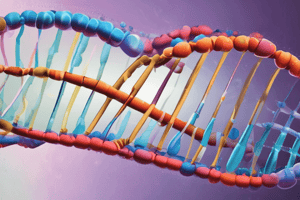Podcast
Questions and Answers
How many replication bubbles do prokaryotes typically have?
How many replication bubbles do prokaryotes typically have?
- Several
- One (correct)
- None
- Two
In what direction does DNA synthesis proceed with respect to the new daughter strand?
In what direction does DNA synthesis proceed with respect to the new daughter strand?
- 2' - 3'
- 3' - 5'
- 5' - 3' (correct)
- 5' - 5'
What are Okazaki fragments?
What are Okazaki fragments?
- Long fragments of RNA produced on the lagging strand
- Short fragments of DNA produced by discontinuous synthesis on the leading strand
- Fragments of RNA on the leading strand
- Short fragments of DNA produced by discontinuous synthesis on the lagging strand (correct)
Which enzyme is responsible for adding nucleotides to a growing DNA strand?
Which enzyme is responsible for adding nucleotides to a growing DNA strand?
Which of the following statements is true about eukaryotic DNA replication?
Which of the following statements is true about eukaryotic DNA replication?
What role does the DNA polymerase play in DNA replication?
What role does the DNA polymerase play in DNA replication?
Where does DNA replication begin?
Where does DNA replication begin?
What is produced by RNA primase during DNA replication?
What is produced by RNA primase during DNA replication?
Which enzyme extends DNA on the leading strand?
Which enzyme extends DNA on the leading strand?
What are the short fragments synthesized on the lagging strand called?
What are the short fragments synthesized on the lagging strand called?
Which enzyme removes the RNA primer during DNA replication?
Which enzyme removes the RNA primer during DNA replication?
What is the role of DNA ligase in DNA replication?
What is the role of DNA ligase in DNA replication?
Which statement is true about the replication fork?
Which statement is true about the replication fork?
During which step is the 2nd Okazaki fragment synthesized?
During which step is the 2nd Okazaki fragment synthesized?
What is the term for DNA replication that results in each new DNA molecule containing one original strand and one new strand?
What is the term for DNA replication that results in each new DNA molecule containing one original strand and one new strand?
What provides the catalysis for the 3' hydroxyl group to attack the phosphate of a 5'-deoxynucleoside triphosphate?
What provides the catalysis for the 3' hydroxyl group to attack the phosphate of a 5'-deoxynucleoside triphosphate?
Which enzyme removes a 'turn' of the DNA and is a critical target for antibiotics?
Which enzyme removes a 'turn' of the DNA and is a critical target for antibiotics?
Which enzyme is responsible for breaking hydrogen bonds between complementary base pairs during DNA replication?
Which enzyme is responsible for breaking hydrogen bonds between complementary base pairs during DNA replication?
What is required for DNA polymerase to initiate synthesis?
What is required for DNA polymerase to initiate synthesis?
Which of these is a function of RNA primase in DNA replication?
Which of these is a function of RNA primase in DNA replication?
Which of these is NOT a factor involved in DNA replication?
Which of these is NOT a factor involved in DNA replication?
Which of the following enzymes seals the backbone of DNA during DNA replication?
Which of the following enzymes seals the backbone of DNA during DNA replication?
Flashcards are hidden until you start studying
Study Notes
DNA Replication
The Replication Bubble
- DNA replication occurs in a bidirectional manner, resulting in a replication bubble
- Prokaryotes have one replication bubble, while eukaryotes have multiple
- Two replication forks moving in opposite directions form a replication bubble
Mechanisms of DNA Synthesis
- DNA synthesis occurs in two directions: leading strand and lagging strand
- Leading strand synthesis is continuous, whereas lagging strand synthesis is discontinuous
- Nucleotides are added 5' - 3' along the new daughter strand
- DNA polymerase reads 3' - 5' along the leading strand from the RNA primer
DNA Polymerase
- DNA polymerase can only add nucleotides to a growing polymer
- Part of the replisome complex with other proteins such as PCNA
Process of DNA Replication
- The process begins with the unwinding of the double helix at the origin of replication
- RNA primase synthesizes a short RNA primer, which is later removed and replaced by DNA
- DNA polymerase III extends the DNA strands
- Okazaki fragments are formed on the lagging strand
- DNA polymerase I removes the RNA primer and replaces it with DNA
- DNA ligase joins the adjacent DNA fragments
Okazaki Fragments
- Short fragments of DNA produced by discontinuous synthesis on the lagging strand
- DNA synthesis on the lagging strand is discontinuous, resulting in Okazaki fragments
Enzymes Involved
- DNA Gyrase or Topoisomerase: removes 'turns' of DNA, critical target for blocking cell replication
- DNA Helicase: breaks hydrogen bonds between complementary base pairs, forming the replication fork
- Single strand binding protein: maintains the stability of the replication fork
- RNA Polymerase (RNA Primase): synthesizes a short RNA primer
- DNA Polymerase: synthesizes DNA strands
- DNA Ligase: joins adjacent DNA fragments
DNA Gyrase
- A topoisomerase II enzyme that causes a double-strand break and loops one strand under another
- Removes a 'turn' of DNA, critical for cell replication
DNA Helicase
- Breaks hydrogen bonds between complementary base pairs, forming the replication fork
- Maintains the stability of the replication fork with single strand binding proteins
RNA Primase
- Synthesizes a short RNA primer, which is later removed and replaced by DNA
- Follows base pairing rules (A-U), later replaced by DNA and sealed by DNA ligase
Studying That Suits You
Use AI to generate personalized quizzes and flashcards to suit your learning preferences.




